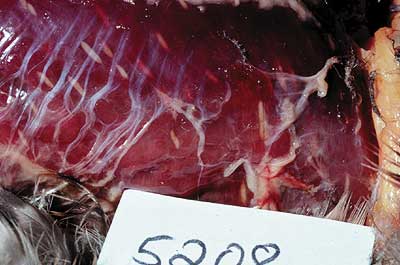Parasites and Diseases
Sarcocystosis
A Field Guide
TO COMMON WILDLIFE DISEASES
AND PARASITES IN ALASKA
SARCOCYSTOSIS (“ricebreast” of ducks)

Sarcocysts in breast muscle of duck.
| What causes sarcocystosis? |
- Sarcocystosis is caused by the cyst stage of a single-celled parasite.
- Lifecycle: The parasite needs a waterfowl host and a carnivore host. The parasite multiplies in the waterfowl forming cysts in the muscles. The carnivore becomes infected when it eats meat from a duck with cysts. The parasite reproduces in the carnivore’s intestine without harming the carnivore. It comes out in the carnivore’s droppings and contaminates vegetation, which is eaten by ducks.
| Where does sarcocystosis occur? |
- Sarcocystosis occurs in many species of ducks throughout Alaska.
| What are the signs of sarcocystosis? |
- Waterfowl and carnivore hosts usually appear healthy.
- When butchering infected ducks, cysts may be observed in the breast muscle.
- Cysts may look like grains of rice (whitish streaks) running in the direction of the muscle fibers.
| How can I protect myself? |
- Humans cannot be infected by the cysts of Sarcocystis spp. in meat.
| Can I eat the meat? |
- Meat from an infected duck is suitable for human consumption.
- Cooking will kill the parasite.
- Do not feed infected meat to dogs.
| Samples to collect |
- Breast muscle of ducks.
- To report an occurrence or to submit a sample for identification/analysis, contact the DWC Wildlife Disease Surveillance reporting hotline 907-328-8354, send an email to dfg.dwc.vet@alaska.gov or visit your local ADF&G office.
